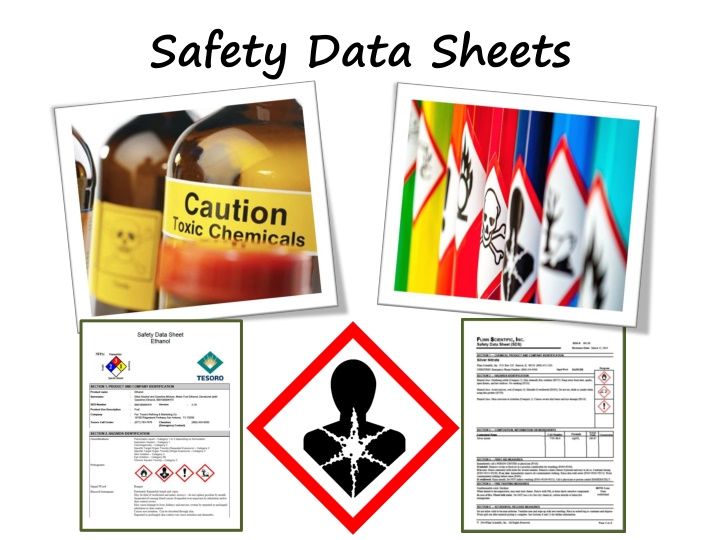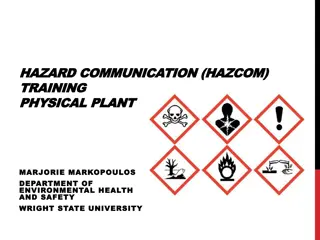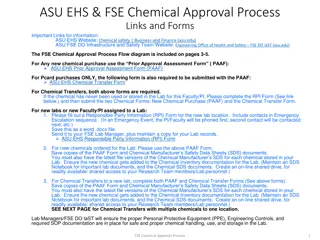
Safety Data Sheets (SDS) and Their Importance in Chemical Management
Safety Data Sheets (SDS), formerly known as Material Safety Data Sheets (MSDS), play a crucial role in chemical management by providing vital information on hazards, handling procedures, and safety measures. Globally Harmonized System (GHS) standards ensure consistent classification and communication of chemical risks, enhancing protection of human health and the environment. SDS consist of various sections including identification, hazards, composition, first-aid measures, fire-fighting procedures, and more, aiding users in understanding and safely handling chemicals.
Download Presentation

Please find below an Image/Link to download the presentation.
The content on the website is provided AS IS for your information and personal use only. It may not be sold, licensed, or shared on other websites without obtaining consent from the author. If you encounter any issues during the download, it is possible that the publisher has removed the file from their server.
You are allowed to download the files provided on this website for personal or commercial use, subject to the condition that they are used lawfully. All files are the property of their respective owners.
The content on the website is provided AS IS for your information and personal use only. It may not be sold, licensed, or shared on other websites without obtaining consent from the author.
E N D
Presentation Transcript
Globally Harmonized System (GHS) Defining health, physical and environmental hazards of chemicals; Creating classification processes that use available data on chemicals for comparison with the defined hazard criteria; and Communicating hazard information, as well as protective measures, on labels and Safety Data Sheets (SDS).
What are SDS Safety Data Sheets (SDS known as Material Safety Data Sheets (MSDS) The purpose of classification under the GHS is to provide consistent information to users of chemicals with the goal of enhancing protection of human health and the environment
Safety Data Sheets Old & New Yes MSDS are still valid All manufacturers were required and should have updated Safety Data Sheets by now (SDS)
16 Categories on SDS 9. Physical and Chemical Properties 10. Stability and reactivity 11. Toxicological information 12. Ecological information 13. Disposal considerations 14. Transport information 15. Regulatory information 16. Other information 1. Identification 2. Hazard(s) identification 3. Composition/information on ingredients 4. First-aid measures 5. Fire-fighting measures 6. Accidental release measures 7. Handling and Storage 8. Exposure controls/personal protection
Sections of SDS 1. Identification 2. Hazard(s) Identification Chemical Product and Company Identification Chemical Hazards Name of chemical & information on manufacturer including address and contact phone number Identifies the hazards of the chemical and Symptoms of Overexposure Pictograms may be presented based on chemical hazards , in two ways: as graphical reproductions of the symbols in black and white or be a description of the name of the symbol
Sections of SDS 4. First-aid measures 3. Composition & Information on ingredients What First-aid measures are needed if exposed to the hazard List ingredients in the chemical, CAS # & percent of ingredient makeup 5. Fire-fighting measures Includes information on Extinguishing Media, Special Fire Fighting Procedures & Unusual Fire and Explosion Hazard.
Sections of SDS 6. Accidental release measures What measures are needed if there is an accidental release/spill 8. What is this Category? 7. Handling and Storage Explains what type of engineering controls and personal protective equipment is needed when using the chemical How to handle the chemical safely, and safe storage requirements
Hazardous Material Spill/Release In the event of a chemical spill/release: Evacuate and prevent access to area Notify the site administrator Do not ask untrained individuals to clean up Call the Safety Office (858) 627-7174
Sections of SDS 9. Physical and Chemical Properties 10. Stability and Reactivity What would this section include? Boiling Point, Solubility in Water, Vapor Pressure, Percent Volatile, Coefficient of Water/Oil Distribution, Flash Point & Pour Point 11. Toxicological information Information, either for the ingredients of the product or the product as a whole. Includes routes of exposure; related symptoms, acute and chronic effects; numerical measures of toxicity.
Sections of SDS 12. Ecological Provides information to evaluate the environmental impact of the chemical(s) if it were released to the environment. 13. Disposal considerations Provides guidance on proper disposal practices, recycling or reclamation of the chemical(s) or its container, and safe handling practices.
Sections of SDS 15. Regulatory information 14. Transport information What are the shipping requirements, including the packing of the chemical and shipping mode; air, ground or ocean The regulatory requirements including but not limited to, CERCLA, SARA TITLE III, EPA Toxic Substances Control Act (TSCA) 16. Other information Any other information that may not have been included in other sections. Example, HMIS Hazard Rating: Health 1 (slight hazard), Fire Hazard 4 (severe hazard), Reactivity 0 (minimal hazard)
Keeping a Copy of SDS Have a Hard Copy available in an accessible area where chemicals are being used This includes but are not limited to the following areas: Main Office Science Custodial Fine Arts/graphic arts/industrial art Ceramic Arts Auto shop Landscape ASB Wood Shop Paint Body Shop Metal Working Shop
Helpful Links CA-OSHA Hazard Communication Standard 5194 http://www.dir.ca.gov/title8/5194-May-6- 2013.html Fed-OSHA detailed description on sections of Safety Data Sheets https://www.osha.gov/Publications/OSHA3514. html
Environmental Health & Safety Questions Visit our website https://www.sandi.net/sta ff/safety- management/safety- management Safety Office 858-627-7174






















